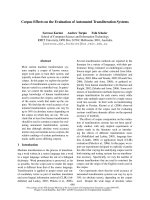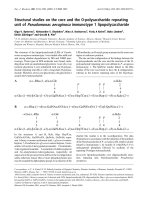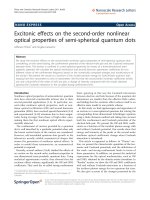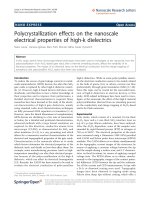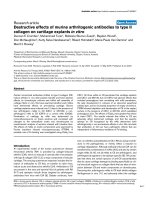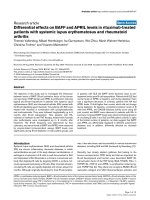Báo cáo y học: " Corticosteroid effects on ventilator-induced diaphragm dysfunction in anesthetized rats depend on the dose administered" pptx
Bạn đang xem bản rút gọn của tài liệu. Xem và tải ngay bản đầy đủ của tài liệu tại đây (724.17 KB, 8 trang )
RESEA R C H Open Access
Corticosteroid effects on ventilator-induced
diaphragm dysfunction in anesthetized rats
depend on the dose administered
Karen Maes
1
, Anouk Agten
1
, Ashley Smuder
2
, Scott K Powers
2
, Marc Decramer
1
, Ghislaine Gayan-Ramirez
1*
Abstract
Background: High dose of corticosteroids has been previously shown to protect against controlled mechanical
ventilation (CMV)-induced diaphragmatic dysfunction while inhibiting calpain activation. Because literature suggests
that the calpain inhibiting effect of corticosteroid depends on the dose administered, we determined whether
lower doses of corticosteroids would also provide protection of the diaphragm during CMV. This may be important
for patients undergoing mechanical ventilation and receiving corticosteroids.
Methods: Rats were assigned to controls or to 24 hours of CMV while being treated at the start of mechanical
ventilation with a single intramuscular administration of either saline, or 5 mg/kg (low MP) or 30 mg/kg (high MP)
of methylprednisolone.
Results: Diaphragmatic force was decreased after CMV and this was exacerbated in the low MP group while high
MP rescued this diaphragmatic dysfunction. Atrophy was more severe in the low MP group than after CMV while
no atrophy was observed in the high MP group. A significant and similar increase in calpain activity was observed
in both the low MP and CMV groups whereas the high dose prevented calpain activation. Expression of
calpastatin, the endogenous inhibitor of calpain, was decreased in the CMV and low MP groups but its level was
preserved to controls in the high MP group. Caspase-3 activity increased in all CMV groups but to a lesser extent
in the low and high MP groups. The 20S proteasome activity was increased in CMV only.
Conclusions: Administration of 30 mg/kg methylprednisolone during CMV protected against CMV-induced
diaphragm dysfunction while 5 mg/kg was more deleterious. The protective effect is due mainly to an inhibition of
the calpain system through preservation of calpastatin levels and to a lesser extent to a caspase-3 inhibition.
Background
Corticosteroids are among the most widely used drugs
in the world and are effective in the treatment of many
inflammatory and immune diseases. However, one of
the main side-effects of systemically administered corti-
costeroids is skeletal muscle myopathy, involving
respiratory as well as peripheral muscles. The incidence
of steroid-induced myopathy varies from 7% [1] to 60%
[2] in patients receiving glucocorticoid treatment for
various diseases. Glucocorticoids have been shown to
cause mainly at rophy of fast-twitch type II muscle fibers
with less or no impact on type I fibers [3]. In skeletal
muscle, glucocorticoids decrease the rate of muscle pro-
tein synthesis and increase the rate of muscle proteolysis
[4]. The stimulatory effect of corticosteroids on muscle
proteo lysi s results from the activation of the proteolytic
system s such as the ubiquitin-prote asome system (UPS),
the lysosomal system, the calcium-dependent calpain
system and the caspase-3 system [5,6].
Although the effect s of corticosteroids on muscle pro-
teolysis are well documented, the protective effect of
corticosteroids on protein degradation is less recognized.
In some circumstances, corticosteroids have been shown
toinhibitthecalpainsystem[7-10]andthecaspase-3
system [11-13]. For calpain, in vitro degradation of neu-
rofilament proteins from ra t spinal cord homogenates
through calpain activation, was substantially inhibited by
cort icosteroids in a dose-dependent fashion [7]. A lso, in
* Correspondence:
1
Respiratory Muscle Research Unit, Laboratory of Pneumology and
Respiratory Division, Katholieke Universiteit Leuven, B-3000 Leuven Belgium
Full list of author information is available at the end of the article
Maes et al. Respiratory Research 2010, 11:178
/>© 2010 Maes et al; licensee BioMed Central Ltd. This is an Open Access article distributed under the terms of the Creative Commons
Attribution Lic ense ( which permits unrestricted use, distribution, and reproduction in
any medium, provided the original work is properly cited.
a rat model of ischemia-induced liver injury, pretreat-
ment with prednisolone (10mg/kg,corresponding
~1.6 mg/kg in humans) abolished calpain activation in
the liver [14]. Interestingly, in this study the calpain-
inhibiting effect of corticosteroids was shown to de pend
on the dose administered, being minimal at low concen-
trations. Recently our group showed that administration
of a single h igh dose of methylprednisolone (80 mg/kg,
correspond ing ~13 mg/kg in humans) during controlled
mechanical ventilation protected the diaphragm from
the deleterious effects of prolonged mechanical ventila-
tion through inhibition of the calpain system [9]. This
study and a previous CMV study, in which we used a
calpain inhibitor [9], confirm the important role of the
calpain system in the development of VIDD. It is known
that three major proteolytic systems are upregulated in
the diaphragm during mechanical ventilation: the ubi-
quitin proteasome system (UPP), the Ca
2+
-dependent
calpain system and the lysosomal system [15-17].
Although the UPP is considered a major proteolytic sys-
tem in skeletal muscle, it cannot degrade intact myo-
filaments. Release of myofilaments for subsequent
degradadtion by the UPP occurs by the calpain and/or
caspase system and may be the rate-limiting step in ske-
letal muscle proteolysis [18].
In regard to pa tients undergoing prolonged mechani-
cal ventilation, it is important to know whether lower
doses of corticosteroids, as used in the clinical practice,
can also provide protection against mechanical ventila-
tion-induced diaphragmatic weakness.
Since the literature supports the fact that the c alpain-
inhibiting effect of corticosteroids depends on the dose
administered, the aim of the present study was t o deter-
mine whether administration of lower doses of corticoster-
oids would provide protection against ven tilator-induced
diaphragm dysfunction (VIDD).
Methods
Experimental procedure
Male Wistar rats were randomly assigned to one of four
experimental groups: control (C, n = 9), 24 hours of
mechanical ventilation receiving an intramuscular injec-
tion of saline (CMV, n = 9) or methylprednisolone (MP)
at a low dose (5 mg/kg, MP-5, n = 7) or at high dose (30
mg/kg, MP-30, n = 6). The study was approved by the ani-
mal experiments committee of the Medical Faculty of the
Katholieke Universiteit Leuven. Rats were tracheotomized
and the jugular vein was cannulated for continuo us infu-
sion of Pentobarbital. A catheter was inserted into the
carotid artery to permit continuous blood pressure mea-
surements and the collection of blood to measure blood
gases. Body temperature was conti nuously maint aine d at
37°C. Rats received an intramuscular injection of either
saline or methylprednisolone (5 mg/kg, corresponding
~0.8 mg/kg in humans [19]) or 30 mg/kg, (corresponding
~4.8 mg/kg in humans [19]) at the start of the 24 h
mechanical ventilation protocol. The doses of methylpred-
nisolone were pharmacologically scaled to the animal’s
metabolic rate which makes the dose compatible with
human dosages. Appropriate conversion of drug doses
from animal to humans can be calculated as previously
recommended [19]. Upon completion of mechanical venti-
lation, the diaphragm was quickly excised and a strip was
use d for in vitro contractile properties, as described pre-
viously[20],whiletheremainingpartwasfrozenfor
further analysis.
Histochemistry
Serial sections of the costal diaphragm were stained with
hematoxylin and eosin and for myofibrill ar adenosine
triphosphatase to determine cross-sectional area (CSA)
and proportion of the fibers, as described previously
[20].
Western blot
Talin, aII-spectrin and calpastatin, the endogenous inhibi-
tor of calpain I and II, were measured by western blotting.
Proteolysis of talin, a preferential intracellular substrate of
calpain, was i nvestigated as an i ndirect measurement of
calpain activity. Measurement of the caspase-3 mediated
cleavage of aII-spectrin was used to assess caspase-3 activ-
ity. Diaphragm was homogenized in a buffer containing
100 mM KPO
4
and total protein concentration was deter-
mined with the Bradford method. Proteins were separated
on a polyacrylamide gel and transferred onto a polyvinyl-
difluoride membrane. Blots were incubated overnight at
4°C with a primary antibody against talin (Sigma), calpas-
tatin (Sigma) or aII-spectrin (Tebu-Bio) and with the
appropriate secondary antibodies. For calpastatin, data
were corrected for alpha-tubulin (Sigma) to ensure equal
loading. Since calpain activity and caspase-3 activity are
expressed as the ratio between breakdown products and
intact protein, corrections for equal loading with alpha-
tubulin were not performed. Ponceau S staining was
performed for each blot to ensure proper transfer of the
proteins. Proteins were visualized with ECL (Amersham)
and analyzed with the software package (Bio 1D) of the
imaging system (Photo print, Vilber, France).
20S proteasome activity
To determine the impact of our experimental treatments
on proteasome activation in the diaphragm, we used a
well-established kinetic fluorometric assay [21].
Statistical analysis
Statistical analysis was performed with the GraphPad
prism software (version 4.01, GraphPad, San diego, CA,
USA). Population distribution was evaluated with the
Maes et al. Respiratory Research 2010, 11:178
/>Page 2 of 8
D’ Agostino and Pearson omnibus normality test. Com-
parisonsbetweenthegroupsweremadebyaone-way
analysis of variance. When appropriate, a Newman-
Keuls Multiple Comparison Test was performed post
hoc. Correlation analyses were performed using Pear-
son’s coefficient of correlation. Significance was estab-
lished at p < 0.05. Values are reported as mean ± SD.
Results
Systemic and biologic response to CMV
Arterial blood pressure was similar between the 4
groups. Blood pH, PO
2
and PCO
2
were maintained
within the normal levels and were not different between
the groups (Table 1).
Diaphragm in vitro contractile properties
In the CMV group the force-frequency curve shifted
downwards when compared to C, as previously shown
(Figure 1 upper panel). In the MP-5 group, diaphragm
force was further reduced compared to C and MP30. By
contrast in the MP-30 group, diaphragm force was simi-
lar to t hat of C at all stimulation frequencies. Tetanic
tension was decreased with 30% after CMV when com-
pared to C and with an additional 15% in the MP-5
group(p<0.01vsothers)whileitwasunchangedin
the MP-30 group (Figure 1 lower panel).
Histochemistry
Proportions of the different fiber types were similar
between all groups. Compared to C, diaphragm CSA of
the type IIx/b fibers was s ignificantly decreased with
29% after CMV, as previously shown, and with an addi-
tional 16% in the MP-5 group. CSA of the type IIa
fibers were decreased in the MP-5 group only (-31%
vs C, p < 0.01) (Figure 2). In the MP-30 group CSA of
the different fiber types remained unchanged and
similar to that of C.
Western blot analysis of calpain, calpastatin and caspase-3
Calpain activity, measured by talin degradation, was sig-
nificantly elevated after CMV, as previously shown, and
to a similar extent in the MP-5 group when compared
to C (Figure 3). In the MP-3 0 group, talin degradation
was similar to control levels.
Calpastatin levels were significantly and similarly
decreased after CMV and after administration of 5 mg/kg
MP compared with controls (Figure 4). In the MP-30
group, calpastatin expression was similar to that of the
control group.
Analysis of the caspase-3 mediated cleavage of aII-
spectrin revealed that CMV induced a significant rise in
caspase-3 activity w hen compared to C (+149%, p <
0.001). Caspase-3 activity was similarly increased in the
MP-5 and the MP-30 group (+96% and +78% respec-
tively, p < 0.05 vs C) but this increase was significantly
less compared to that of CMV (Figure 5).
Significant negative correlations were found between
calpain activity and diaphragm force (-0.50<r < -0.41,
p < 0.05) as well as with CSA of the type IIx/b fibers
Table 1 Blood gas data and arterial blood pressure
PaO
2
(mmHg) PaCO
2
(mmHg) pH PA (mmHg)
CMV 148 ± 56 26 ± 4 7.57 ± 0.10 94 ± 29
MP-5 148 ± 59 34 ± 12 7.51 ± 0.12 95 ± 22
MP-30 121 ± 61 35 ± 10 7.45 ± 0.14 131 ± 31
Blood gases and arterial blood pressure in animals under controlled
mechanical ventilation treated with either saline (CMV) or with 5 mg/kg
methylprednisolone (MP-5) or 30 mg/kg of methylprednisolone (MP-30). For
the control (C) group no hemodynamic measurements are available. Values
are mean ± SD.
Figure 1 Diaphragm force generation. Upper panel: Force-
frequency relationship in the diaphragm of controls (C, open
rectangles, n = 9), controlled mechanical ventilation animals treated
either with saline (CMV, closed triangles, n = 9) or with 5 mg/kg
methylprednisolone (MP-5, open circles, n = 7) or 30 mg/kg
methylprednisolone (MP-30, closed circles, n = 6). Maximal tetanic
tension in the diaphragm of C, CMV, MP5 and MP30 groups. Values
are means ± SD. *p < 0.001 CMV and MP-5 vs others, #p < 0.01
CMV vs C and MP-30, ++p < 0.01 MP-5 vs MP-30, +p < 0.05 MP-5
vs MP-30.
Maes et al. Respiratory Research 2010, 11:178
/>Page 3 of 8
(r = -0.57, p < 0.02). Significant positive correlation were
observed between calpastatin and diaphragm force
(0.43<r < 0.54, p < 0.05) and calpastatin and CSA of the
type IIx/b fibers (r = 0.57, p < 0.02).
20S proteasome activity
Compared to control, the chymotrypsin-like activity of
the 20S proteasome wa s increased (p < 0.05) by 48% in
diaphragms from the CMV group. In contras t, both the
low dose (MP-5) and high dose (MP-30) of corticoster-
oids preven ted the CMV-induced proteasom e activation
in the diaphragm.
Discussion
Overview of principle findings
This is the first study to demonstrate that the protective
effect of corticosteroids against VIDD depends on the
dose administered and results mainly from an inhibition
of the calpain system and to a lesser extent from a
reduction in caspase-3 activation. Administration of
relatively low dose of methylprednisolone (5 mg/kg)
resulted in an exacerbation of diaphragm dysfunction
and atrophy. None of these effects were observed with
the higher dose of methylprednisolone (30 mg/kg), a
dose that fully protected the diaphragm against the
effects of CMV.
Corticosteroids and skeletal muscle
Corticosteroids are known to decrease muscle synthesis
and to accelerate protein degradation [4]. I n vivo
Figure 2 Diaphragm cross-sectional area of the different fiber
types. Diaphragm cross-sectional area (CSA) of the type I, IIa and
IIx/b fibers in the controls (C, n = 6) and controlled mechanical
ventilation animals treated either with saline (CMV, n = 6) or with
5 mg/kg methylprednisolone (MP-5, n = 6) or 30 mg/kg
methylprednisolone (MP-30, n = 5). Values are means ± SD. *p <
0.05 vs C and MP-30, #p < 0.05 vs CMV, +p < 0.01 vs C.
Figure 3 Western blot analysis of talin. Upper panel: A representative western blot for the analysis of intact and cleaved talin (BDP) i n the
diaphragm of controls (C, n = 6) and controlled mechanical ventilation with saline injection (CMV, n = 9) or with 5 mg/kg methylprednisolone
(MP-5, n = 7) or 30 mg/kg methylprednisolone (MP-30, n = 5). Lower panel: Mean densitometric values for talin degradation by calpain. Values
are shown as the ratio of degraded talin to intact protein and are expressed as means ± SD, *p < 0.05 vs others.
Maes et al. Respiratory Research 2010, 11:178
/>Page 4 of 8
administration of corticosteroids to animals has been
shown to stimulate the different proteolytic systems
[22-26]. On the other hand, there are also evidences
suggesting that corticosteroids may provide beneficial
effects on skeletal muscles. In patients with Duchenne
muscular dystrophy, treatment with prednisolone signifi-
cantly improved muscle strength and this beneficial
effect appeared to be associated with an increase in
muscle mass probably mediated by inhibition of muscle
proteolysis rather than by stimulation of muscle protein
synthesis [27]. Inhibition of muscle proteolysis, in parti-
cular the calpain system, by corticosteroids has been
suggested in several in vitro [7,19,28,29] and in vivo
[14,30,31] studies. In addition, treatment with methyl-
prednisolone has been shown to reduce caspase-3
mRNA and protein expression in several animal
models [11-13].
Corticosteroids and the calpain system
The ability of co rticosteroids to inhibit calpain seems to
depend on the dose administered. An in vitro study
showed that methylprednisolone was slightly effective at
low concentrations while more than 80% of calpain inhi-
bition was observed with high concentrations [7]. This
was also confirmed in several in vivo studies where dif-
ferent doses of corticosteroids were administered to ani-
mals. In r abbits, calpain activation caused by hypoxia
was prevented by betametasone pretreatment, indicating
inhibition of calpain activation [30]. In a rat model
of ischemia-induced liver injury pretreatment of animals
with 10 mg/kg of prednisolone (corresponding
~1.6 mg/kg in humans [19]) significantly i nhibited cal-
pain activation in the liver while lower doses (1 mg/kg,
Figure 4 Western blot analysis of calpastatin. Upper panel: A representative western blot for calpastatin and a-tubulin in the diaphragm of
controls (C, n = 6) and controlled mechanical ventilation with saline injection (CMV, n = 8) or with 5 mg/kg methylprednisolone (MP-5, n = 7)
or 30 mg/kg methylprednsiolone (MP-30, n = 5). Lower panel: Densitometric values for calpastatin corrected for a-tubulin. Values are means ±
SD, *p < 0.05 vs others.
Figure 5 Western blot analysis of aII-spectrin. Densitometric
values for aII-spectrin degradation by caspase-3. Values are shown
as the ratio of degraded aII-spectrin to intact protein and are
expressed as means ± SD, *p < 0.01 vs C, #p < 0.05 vs CMV.
Maes et al. Respiratory Research 2010, 11:178
/>Page 5 of 8
corresponding ~0.2 mg/kg in humans [19]and 3 mg/kg,
corresponding ~0.5 mg/kg in humans [19]) did not [8].
Also a dose of 30 mg/kg of corticosteroids adminis tered
to piglets (corresponding ~6.5 mg/kg in huma ns [19])
before and during cardiopulmonary bypass was able to
reduce the percentage of degraded troponin I while pre-
serving calpastatin activity levels [31]. This is interesting
knowing that the dose of 30 mg/kg is currently used in
patients undergoing cardio-pulmonary bypass [32-34].
The precise mechanisms by which corticosteroids
inhibit calpain activity remain unclear. Nonetheless,
based upon our current knowledge regarding calpain
regulation, a bride discussion of calpain regulation in
the diaphragm during prolonged CMV is warrante d.
Calpain is a Ca
2+
-dependent cytosolic protease which is
typically in an inactive state under basal conditions. Cal-
cium is the most important activator of calpain. Binding
of calcium to calpain leads to conformational changes of
the molecule allowing activation of its catalytic site. An
additional important regulator of calpain activity is its
endogenous inhibitor calpastatin [18]. Evidence exists
that corticosteroids might protect against calpain activa-
tion by preventing an increase in cytosolic calcium
levels. In mdx muscle fibers , a condition in which cyto-
solic Ca
2+
is in creased, treatment with methylpredniso-
lone attenuated the rise in cytosolic free calcium
following hypo-osmotic stress [35]. On the other hand,
preservation of calpastatin levels was associated with
calpain inhibition after MP treatment in a piglet model
of cardiopulmonary bypass [31]. Therefore, in the cur-
rent experiments, it is possible that the MP treatment
inhibited CMV-induced calpain activation in the dia-
phragm by preventing an increase in cytosolic Ca
2+
levels, preservation of ca lpastatin levels, or some combi-
nation of both. Additional experiments will be required
to provide a complete understanding of this issue.
Corticosteroids and mechanical ventilation
Animal studies have clearly demonstrated that CMV
impacts the diaphragm by pro moting contractile dys-
function, increased proteolysis and atrophy [ 17,36].
Interestingly, our results reveal that administration of a
relatively low dose of methylprednisolone (5 mg/kg, cor-
responding ~0.8 mg/kg in humans [19]) exacer bates the
CMV-induced diaphragm dysfunction, whereas a higher
dose (30 mg/kg, corresponding ~5 mg/kg in humans
[19]) completely protected the diaphragm against VIDD.
The dose-depending effect of corticosteroids are in
agreement with previous studies [7,8,31]. Our finding of
a negative correlation between calpain activity and either
diaphragmatic force production or diaphragm fiber CSA
further supports the notion that calpain activation plays
an important role in CMV-induced diaphragmatic atro-
phy and contractile dysfunction. In our previous study
we also showed that administration of 80 mg/kg (corre-
sponding ~13 mg/kg in humans [19]) of MP during
CMV protected against VIDD [9]. By contrast, CMV in
combination with 80 mg/kg of MP in rabbits (corre-
sponding ~28 mg/kg in humans [19]) showed no pro-
tection of VIDD after 1, 2 or 3 days of CMV [37]. It is
unclear whether the discrepancy between our results
and this work is related to species differences (rat vs
rabbit) or to the duration of MP treatment. Further-
more, the present study also identified a potential role
for calpastatin, the endogenous inhibitor of calpain, in
the protective effect induced by corticosteroids during
prolonged CMV. The positive cor relation found in our
study between calpastatin and diaphragm force or fiber
dimensions further stress the potentially impor tant role
of calpastatin in this model. Inhibition of calpain by MP
through a preservation of calpastatin levels has been
previously reported in a model of cardiopulmonary
bypass [31]. These findings coupled with our data sug-
gest that high doses of corticosteroids may prevent los s
of calpastatin and therefore prevent the activation of cal-
pain in skeletal muscle. It is also possible that the way
MP preserves diaphragm function during controlled
mechanical ventilation might be related to intracellular
cellular calcium levels. Indirect evidence suggests that
prolongedCMVresultsinanincreaseinintracellular
calcium levels in the diaphragm [15]. Therefore protec-
tion against CMV-induced increases in intr acellular cal-
cium levels and/or increasing calpa statin binding to
calpain could be potential mechanisms by which corti-
costeroids prevent activation of the protease calpain and
protect against VIDD. Both of these mechanisms have
been proposed to explain the calpain inhibiting effect of
prednisolone in the isc hemic liver [14] and this protec-
tive effect of corticosteroids was shown to be dependent
on the dose administered.
Surprisingly, our data showed a prevention of the
CMV-induced increase in 20S proteasome activity with
both doses of MP. This is in contrast with previous lit-
erature s howing increases of several components of the
ubiquitin proteasome system after corticosteroids treat-
ment in in vitro [6,38] and in animal studies [22,39].
To our knowledge, only one in vitro study has demon-
strated that treatment of cells (i.e., thymocytes) with
dexamethasone decreased proteasome chymotrypsin-like
activity in cell extracts [40]. Inhibition of the 20S pro-
teasome activity, as observed in the pres ent study, might
be due to the fact that animals were treated with only a
single injection of MP while in most other studies ani-
mals were treated repeatedly with corticosteroids.
Finally our data also indicate that caspase-3 activity
was increased in the diaphragm after CMV and also, but
to a lesser extent, after corticosteroids treatment inde-
pendent of the dose used. Inhibition of caspase-3 by
Maes et al. Respiratory Research 2010, 11:178
/>Page 6 of 8
corticosteroids was previously shown in different animal
models [11-13]. Indeed, administration of methylpredni-
solone (30 or 60 mg/kg) to piglets (corresponding ~6.5
or 13 mg/kg in humans [19]) with cardio-pulmonary
bypass resulted in a reduction of myoca rdial caspase-3
activity [12]. Similar, when 10 mg/kg (corresponding
~1.6 mg/kg in humans [19]) of dexamethasone was
administered to endotoxemic rats, the expression of cas-
pase-3 mRNA in the brain was inhibited [13]. Currently,
the mechanism of t he inhibitory effect of steroids on
caspase-3 expression remains unknown. In the present
study, our data indicate that the effec ts of MP on cas-
pase-3 activity during CMV were independent of the
dose administered. Our data also clearly show that MP
can minimize the deleterious effects of CMV on the dia-
phragm despite the fact that MP treatment did not fully
prevent c aspase-3 activation. We interpret these results
as another indication of the main role played by the cal-
pain system in the development of VIDD.
Conclusions
The effects of corticosteroids on the diaphragm during
CMV depend on the dose ad ministered and relatively
high doses of corticosteroids are required to provide
protection against CMV-induced diap hragmatic atrophy
and contractile dysfunction. The mechanism(s) responsi-
ble for high-dose glucocorticoid-induced diaphragmatic
protection are uncertain but may be linked to the ability
of high doses of corticosteroids to inhibit mainly calpain
activity and caspase-3 but to a lesser extent. The effects
on calpain activity may be related to calpastatin expres-
sion levels.
Acknowledgements
We sincerely thank Mrs. Petra Weckx for cutting and staining the histological
sections. Karen Maes is supported by Research Foundation-Flanders.
Author details
1
Respiratory Muscle Research Unit, Laboratory of Pneumology and
Respiratory Division, Katholieke Universiteit Leuven, B-3000 Leuven Belgium.
2
Department of Applied Physiology and Kinesiology, University of Florida,
Gainesville, Florida, USA.
Authors’ contributions
KM participated in the study design, performed the experiments, data
analysis and drafted the manuscript. AA helped to perform the experiments
and to draft the manuscript. AS carried out the 20S proteasome activity
measurement and analysis and helped drafting the manuscript. SP
participated in the design of the study, interpretation of the data and
helped drafting the manuscript. MD participated in the study design and
conception and helped drafting the manuscript. GGR conceived the study,
participated in the study design and coordination and helped to draft the
manuscript. All authors read and approved the final manuscript.
Competing interests
The authors declare that they have no competing interests.
Received: 11 June 2010 Accepted: 14 December 2010
Published: 14 December 2010
References
1. Askari A, Vignos PJ Jr, Moskowitz RW: Steroid myopathy in connective
tissue disease. Am J Med 1976, 61:485-492.
2. Batchelor TT, Taylor LP, Thaler HT, Posner JB, DeAngelis LM: Steroid
myopathy in cancer patients. Neurology 1997, 48:1234-1238.
3. Dekhuijzen PN, Gayan-Ramirez G, Bisschop A, de Bock V, Dom R, Bouillon R,
et al: Rat diaphragm contractility and histopathology are affected
differently by low dose treatment with methylprednisolone and
deflazacort. Eur Respir J 1995, 8:824-830.
4. Schakman O, Gilson H, Thissen JP: Mechanisms of glucocorticoid-induced
myopathy. J Endocrinol 2008, 197:1-10.
5. Hasselgren PO: Glucocorticoids and muscle catabolism. Curr Opin Clin Nutr
Metab Care 1999, 2:201-205.
6. Sacheck JM, Ohtsuka A, McLary SC, Goldberg AL: IGF-I stimulates muscle
growth by suppressing protein breakdown and expression of atrophy-
related ubiquitin ligases, atrogin-1 and MuRF1. Am J Physiol Endocrinol
Metab 2004, 287:E591-E601.
7. Banik NL, Matzelle D, Terry E, Hogan EL: A new mechanism of
methylprednisolone and other corticosteroids action demonstrated in
vitro: inhibition of a proteinase (calpain) prevents myelin and
cytoskeletal protein degradation. Brain Res 1997, 748:205-210.
8. Wang M, Shen F, Shi LH, Xi T, Li XF, Chen X, et al: Protective effect of
prednisolone on ischemia-induced liver injury in rats. World J
Gastroenterol 2008, 14:4332-4337.
9. Maes K, Testelmans D, Cadot P, Deruisseau K, Powers SK, Decramer M, et al:
Effects of acute administration of corticosteroids during mechanical
ventilation on rat diaphragm. Am J Respir Crit Care Med 2008,
178:1219-1226.
10. Pearl JM, Plank DM, McLean KM, Wagner CJ, Duffy JY: Glucocorticoids
Improve Calcium Cycling in Cardiac Myocytes after Cardiopulmonary
Bypass. J Surg Res 2009.
11. Glanemann M, Strenziok R, Kuntze R, Munchow S, Dikopoulos N, Lippek F,
et al: Ischemic preconditioning and methylprednisolone both equally
reduce hepatic ischemia/reperfusion injury. Surgery 2004, 135:203-214.
12. Pearl JM, Nelson DP, Schwartz SM, Wagner CJ, Bauer SM, Setser EA, et al:
Glucocorticoids reduce ischemia-reperfusion-induced myocardial
apoptosis in immature hearts. Ann Thorac Surg 2002, 74:830-836.
13. Wang H, Wu YB, Du XH: Effect of dexamethasone on nitric oxide
synthase and Caspase-3 gene expressions in endotoxemia in neonate
rat brain. Biomed Environ Sci 2005, 18:181-186.
14. Wang M, Sakon M, Umeshita K, Okuyama M, Shiozaki K, Nagano H,
et al:
Prednisolone suppresses ischemia-reperfusion injury of the rat liver by
reducing cytokine production and calpain mu activation. J Hepatol 2001,
34:278-283.
15. DeRuisseau KC, Shanely RA, Akunuri N, Hamilton MT, Van Gammeren D,
Zergeroglu AM, et al: Diaphragm unloading via controlled mechanical
ventilation alters the gene expression profile. Am J Respir Crit Care Med
2005, 172:1267-1275.
16. DeRuisseau KC, Kavazis AN, Deering MA, Falk DJ, Van Gammeren D,
Yimlamai T, et al: Mechanical ventilation induces alterations of the
ubiquitin-proteasome pathway in the diaphragm. J Appl Physiol 2005,
98:1314-1321.
17. Shanely RA, Zergeroglu MA, Lennon SL, Sugiura T, Yimlamai T, Enns D, et al:
Mechanical ventilation-induced diaphragmatic atrophy is associated
with oxidative injury and increased proteolytic activity. Am J Respir Crit
Care Med 2002, 166:1369-1374.
18. Goll DE, Thompson VF, Li H, Wei W, Cong J: The calpain system. Physiol
Rev 2003, 83:731-801.
19. Reagan-Shaw S, Nihal M, Ahmad N: Dose translation from animal to
human studies revisited. FASEB J 2008, 22:659-661.
20. Dekhuijzen PN, Gayan-Ramirez G, de Bock V, Dom R, Decramer M:
Triamcinolone and prednisolone affect contractile properties and
histopathology of rat diaphragm differently. J Clin Invest 1993,
92:1534-1542.
21. Betters JL, Criswell DS, Shanely RA, Van Gammeren D, Falk D,
DeRuisseau KC, et al: Trolox attenuates mechanical ventilation-induced
diaphragmatic dysfunction and proteolysis. Am J Respir Crit Care Med
2004, 170:1179-1184.
22. Auclair D, Garrel DR, Chaouki ZA, Ferland LH: Activation of the ubiquitin
pathway in rat skeletal muscle by catabolic doses of glucocorticoids. Am
J Physiol 1997, 272:C1007-C1016.
Maes et al. Respiratory Research 2010, 11:178
/>Page 7 of 8
23. Dardevet D, Sornet C, Taillandier D, Savary I, Attaix D, Grizard J: Sensitivity
and protein turnover response to glucocorticoids are different in
skeletal muscle from adult and old rats. Lack of regulation of the
ubiquitin-proteasome proteolytic pathway in aging. J Clin Invest 1995,
96:2113-2119.
24. Deval C, Mordier S, Obled C, Bechet D, Combaret L, Attaix D, et al:
Identification of cathepsin L as a differentially expressed message
associated with skeletal muscle wasting. Biochem J 2001, 360:143-150.
25. Sohar I, Nagy I, Heiner L, Kovacs Z, Guba F: Proteases and proteinase
inhibitors in experimental glucocorticosteroid myopathy. Acta Physiol
Acad Sci Hung 1982, 60:43-51.
26. Zhao W, Pan J, Zhao Z, Wu Y, Bauman WA, Cardozo CP: Testosterone
protects against dexamethasone-induced muscle atrophy, protein
degradation and MAFbx upregulation. J Steroid Biochem Mol Biol 2008,
110:125-129.
27. Rifai Z, Welle S, Moxley RT III, Lorenson M, Griggs RC: Effect of prednisone
on protein metabolism in Duchenne dystrophy. Am J Physiol 1995, 268:
E67-E74.
28. Alderton JM, Steinhardt RA: Calcium influx through calcium leak channels
is responsible for the elevated levels of calcium-dependent proteolysis
in dystrophic myotubes. J Biol Chem 2000, 275:9452-9460.
29. Sur P, Sribnick EA, Patel SJ, Ray SK, Banik NL: Dexamethasone decreases
temozolomide-induced apoptosis in human gliobastoma T98G cells. Glia
2005, 50:160-167.
30. Ostwald K, Hayashi M, Nakamura M, Kawashima S: Subcellular distribution
of calpain and calpastatin immunoreactivity and fodrin proteolysis in
rabbit hippocampus after hypoxia and glucocorticoid treatment.
J Neurochem 1994, 63:1069-1076.
31. Schwartz SM, Duffy JY, Pearl JM, Goins S, Wagner CJ, Nelson DP:
Glucocorticoids preserve calpastatin and troponin I during
cardiopulmonary bypass in immature pigs. Pediatr Res 2003, 54:91-97.
32. Niazi Z, Flodin P, Joyce L, Smith J, Mauer H, Lillehei RC: Effects of
glucocorticosteroids in patients undergoing coronary artery bypass
surgery. Chest 1979, 76:262-268.
33. Schroeder VA, Pearl JM, Schwartz SM, Shanley TP, Manning PB, Nelson DP:
Combined steroid treatment for congenital heart surgery improves
oxygen delivery and reduces postbypass inflammatory mediator
expression. Circulation 2003, 107:2823-2828.
34. Toledo-Pereyra LH, Lin CY, Kundler H, Replogle RL: Steroids in heart
surgery: a clinical double-blind and randomized study. Am Surg 1980,
46:155-160.
35. Leijendekker WJ, Passaquin AC, Metzinger L, Ruegg UT: Regulation of
cytosolic calcium in skeletal muscle cells of the mdx mouse under
conditions of stress. Br J Pharmacol 1996, 118:611-616.
36. Maes K, Testelmans D, Powers S, Decramer M, Gayan-Ramirez G: Leupeptin
Inhibits Ventilator-induced Diaphragm Dysfunction in Rats. Am J Respir
Crit Care Med 2007, 175
:1134-1138.
37. Sassoon CS, Zhu E, Pham HT, Nelson RS, Fang L, Baker MJ, et al: Acute
effects of high-dose methylprednisolone on diaphragm muscle function.
Muscle Nerve 2008, 38:1161-1172.
38. Wang L, Luo GJ, Wang JJ, Hasselgren PO: Dexamethasone stimulates
proteasome- and calcium-dependent proteolysis in cultured L6
myotubes. Shock 1998, 10:298-306.
39. Yin HN, Chai JK, Yu YM, Shen CA, Wu YQ, Yao YM, et al: Regulation of
signaling pathways downstream of IGF-I/insulin by androgen in skeletal
muscle of glucocorticoid-treated rats. J Trauma 2009, 66:1083-1090.
40. Beyette J, Mason GG, Murray RZ, Cohen GM, Rivett AJ: Proteasome
activities decrease during dexamethasone-induced apoptosis of
thymocytes. Biochem J 1998, 332(Pt 2):315-320.
doi:10.1186/1465-9921-11-178
Cite this article as: Maes et al.: Corticosteroid effects on ventilator-
induced diaphragm dysfunction in anesthetized rats depend on the
dose administered. Respiratory Research 2010 11:178.
Submit your next manuscript to BioMed Central
and take full advantage of:
• Convenient online submission
• Thorough peer review
• No space constraints or color figure charges
• Immediate publication on acceptance
• Inclusion in PubMed, CAS, Scopus and Google Scholar
• Research which is freely available for redistribution
Submit your manuscript at
www.biomedcentral.com/submit
Maes et al. Respiratory Research 2010, 11:178
/>Page 8 of 8


